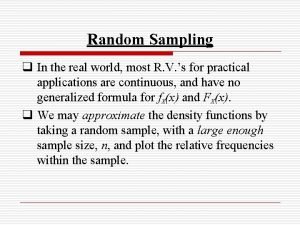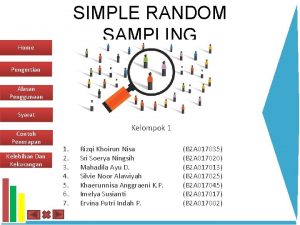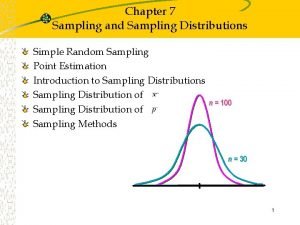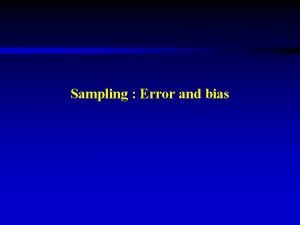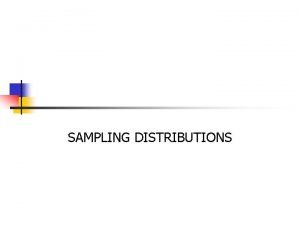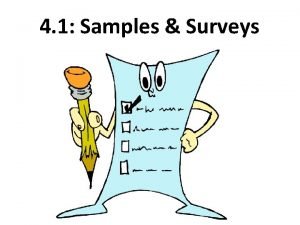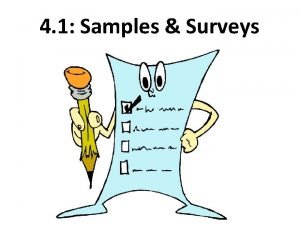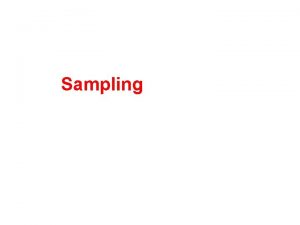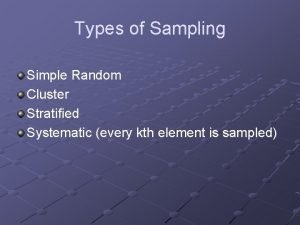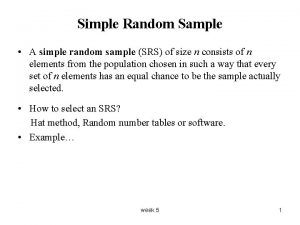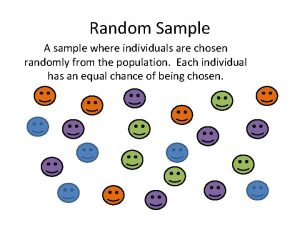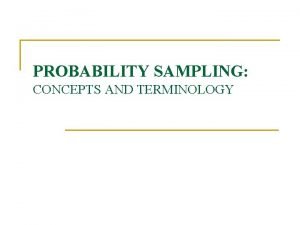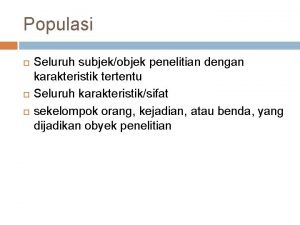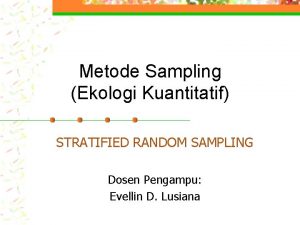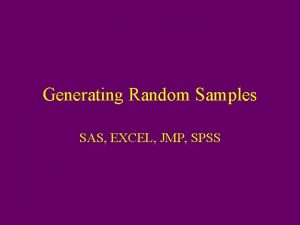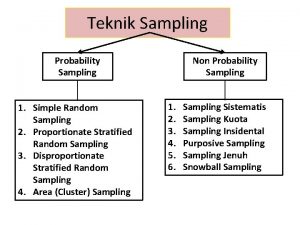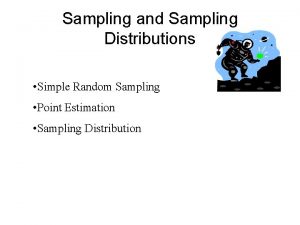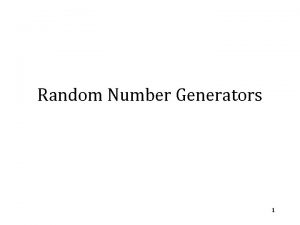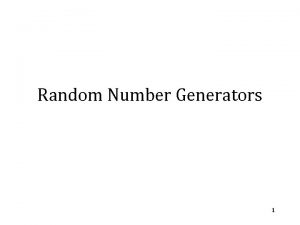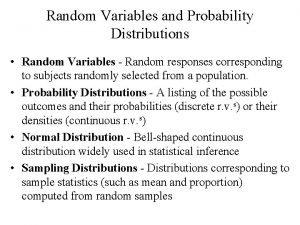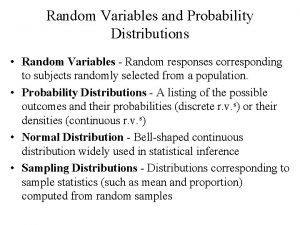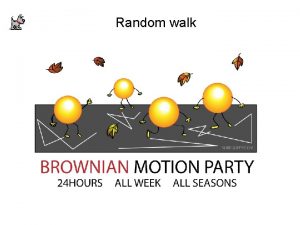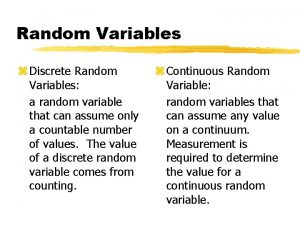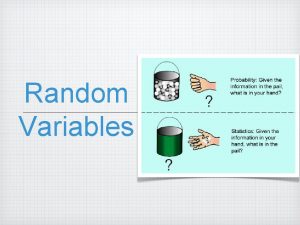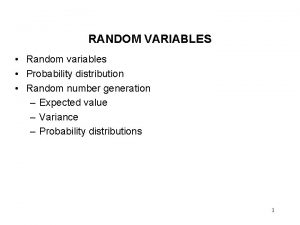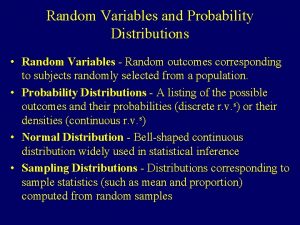Random Sampling q In the real world most





































- Slides: 37

Random Sampling q In the real world, most R. V. ’s for practical applications are continuous, and have no generalized formula for f. X(x) and FX(x). q We may approximate the density functions by taking a random sample, with a large enough sample size, n, and plot the relative frequencies within the sample.

Random Sampling q Examples: q Suppose you wanted to know more information about the GPAs of students enrolled at the U of A q Rather than look up every individual student, you can take a small sample of randomly selected students and figure out their GPAs to project what the GPAs of the entire student body would be. q Taking a poll of registered voters for the presidential election

Random Sampling q The whole idea behind random sampling is to let a part represent the whole.

Random Sampling • Estimate distribution and properties of a random variable by taking a random sample • We consider that all events are independent from one another • Collect a sample with n items (a random sample of size n)

Random Sampling • If we take a large enough sample, the histogram shows us the distribution of the data • This means we know the p. m. f. graph for a finite r. v. or the p. d. f. graph for a continuous r. v. • In addition, the max, min, & mean of a sample should be similar to the max, min, & mean of the variable

Random Sampling • Suppose that X is the number of assembly line stoppages that occur during an 8 -hour shift in our manufacturing plant. • We could obtain a random sample of size 10 by watching the line for 10 different shifts and recording the number of stoppages during each eight hour shift.

Random Sampling • The table below shows the number of work stoppages for various shifts: • A histogram plot of these stoppages gives us a pictorial representation of how this chaotic data behaves.

Random Sampling • The relative frequency histogram plot is shown below:

Random Sampling • Our histogram plot of the relative frequencies for the work stoppage example can be used to approximate the p. m. f. for this situation • Of course, if we increase the number of observations of shifts, our p. m. f. will be more accurate.

Random Sampling • From our example, we can also look at the average number of work stoppages: • The average we just found is sometimes called the sample mean and can be found using:

Random Sampling • Suppose that the assembly line discussed in Example 1 runs 24 hours per day, with workers in three shifts. The sheet Numbers in the Excel file Stoppages. xls contains records of the number of stoppages per shift for nine months (819 shifts).

Random Sampling • Computations in that sheet show that the number of stoppages in the sample ranged from 0 to 14, with a mean of 5. 78. • The sample in Stoppages. xls is much larger than the one of size 10 that we considered in the previous example. • Hence, we would replace the earlier estimate of 6. 3 for E(X) with the new estimate of 5. 78.

Random Sampling • A histogram plot of the relative frequencies also give us a good estimation for the p. m. f.

Random Sampling • We can also use a large sampling to approximate the p. d. f. for a continuous random variable. • Plant manager wants to better understand the delays caused by stoppages of the assemble line. • She is specifically interested in how long they last.

Random Sampling • Let T be the length of time, in minutes, that a randomly selected stoppage will last. • The duration of each of the 4, 734 stoppages that occurred during the 819 shifts was recorded. • This provides a random sample of observations of the continuous random variable T. The times are shown in the sheet Times in the Excel file Stoppages. xls.

Random Sampling • The histogram of times is converted to relative frequencies. We would like to treat this as a p. d. f. • This means the total area must be 1! • To do this the area of each rectangle of our histogram must equal the relative frequency.

Random Sampling • Because we already have made our bins of width 2 we must adjust the heights of our relative frequency so that the area of each rectangle equals the relative frequency. • This is done by taking the relative frequencies and dividing by the bin width • Notice for example the bar whose bin label is 7 has a height of 0. 07, the area of this bar = 2 * 0. 07 = 0. 14, which is the relative frequency for this bin.

Random Sampling • An example of a histogram from the Excel file Stoppages. xls is shown below

Random Sampling • We can create an approximate p. d. f. by connecting the midpoints of the bins at the top of each bar • Although the actual p. d. f. is smooth, this graph gives a good representation

Random Sampling • Simulations used as a predictor • Can give an estimate of what might happen for many trials • Estimate is generally accurate

Random Sampling • Simulation for finite choices • Use RANDBETWEEN function in Excel • Chooses an integer between two values • Ex. =RANDBETWEEN(1, 5) would return a value equal to 1, 2, 3, 4, or 5

Random Sampling • Sample of RANDBETWEEN function

Random Sampling • VLOOKUP function will find information in a table Value in leftmost column Location of table (database) Number value of column (1, 2, 3, …) Usually blank

Random Sampling • Focus on the Project: • In the Excel file Sample. Data. xls on my website, we find that there are 615 arrival values for the 9 a. m. hour. This is a random sample of the random variable A.

Random Sampling • Focus on the Project: • In order to graph the p. m. f. and p. d. f. the heights of the bars must be adjusted • Take relative frequency (percentage) and divide by the bin width to give the new height • This ensures the area under the graph will equal 1

Random Sampling • Focus on the Project: • p. m. f. approximating p. d. f. for variable A

Random Sampling • Focus on the Project: • Approximate p. d. f. and actual p. d. f. for variable A

Random Sampling • Focus on the Project: • Note: (since )

Random Sampling • Focus on the Project: • We find that there are 130 arrival values for the 9 p. m. hour. This is a random sample of the random variable B.

Random Sampling • Focus on the Project: • Note: (since ) we get the following for 9 p. m.

Random Sampling • Focus on the Project: • For the service times, we get

Random Sampling • Focus on the Project: • For the service times, we get the following graph

Random Sampling • Focus on the Project: • You may not change the name of the Excel file Queue Focus. xls • You may not delete or insert any rows, columns, nor cells

Random Sampling • Focus on the Project: • Copy and paste your service time data from your team data into the Excel file Queue Focus. xls on the sheet Data in cells H 45: H? ? ? • This will end with your last service time • You should also increase the numbers in column G

Random Sampling • Focus on the Project: • Note: The sample data contains 8356 service time records • This is the formula that exists in cell E 83 (and continues to cell E 282) in Queue Focus. xls in the sheet Random Sampling =IF(ISNUMBER(D 83), VLOOKUP(RANDBETWEEN(1, 7634), Data!$G$45: Data!$H$7678, 2), "")

Random Sampling • Focus on the Project: • The formula should be modified as follows: =IF(ISNUMBER(D 83), VLOOKUP(RANDBETWEEN(1, 7634), Data!$G$45: Data!$H$7678, 2), "") =IF(ISNUMBER(D 83), VLOOKUP(RANDBETWEEN(1, your last service time), Data!$G$45: Data!$H$your last service time cell, 2), "")

Random Sampling • Focus on the Project: • Change the value in cell D 80 (number of customers) of Queue Focus. xls in the sheet Random Sampling to the number in your team’s Excel file in cell F 18 (number of customers simulation must accommodate)
 Random assignment vs random sampling
Random assignment vs random sampling Panel sampling
Panel sampling Probability sampling
Probability sampling Cluster sampling vs stratified sampling
Cluster sampling vs stratified sampling Sample frame example
Sample frame example Ketchum's strategic planning model
Ketchum's strategic planning model Simple random sampling real life examples
Simple random sampling real life examples Random assignment vs random selection
Random assignment vs random selection Syarat simple random sampling
Syarat simple random sampling Consecutive sampling
Consecutive sampling What is the sample size in qualitative research?
What is the sample size in qualitative research? Complex random sampling design
Complex random sampling design How to use table b in statistics
How to use table b in statistics Yamane formula
Yamane formula Random sampling distribution
Random sampling distribution Simple random sampling pros and cons
Simple random sampling pros and cons Sampling bias
Sampling bias Sampling error examples
Sampling error examples Random sampling poem
Random sampling poem Advantages and disadvantages of stratified sampling
Advantages and disadvantages of stratified sampling Types of sample design
Types of sample design Jenis jenis sampel
Jenis jenis sampel Sampling unit example
Sampling unit example Zhuoyue zhao
Zhuoyue zhao Stratified random sampling adalah
Stratified random sampling adalah Simple random sampling
Simple random sampling Simple random sampling formula
Simple random sampling formula Random sampling
Random sampling Cluster sampling
Cluster sampling Sample frame example
Sample frame example Simple random sampling adalah
Simple random sampling adalah Populasi adalah wilayah generalisasi
Populasi adalah wilayah generalisasi Harry king nomogram
Harry king nomogram Alokasi neyman
Alokasi neyman Desain sampling adalah
Desain sampling adalah What are statistics
What are statistics Random sample generator excel
Random sample generator excel A consumer confidence researcher asks several retailers
A consumer confidence researcher asks several retailers






